Gated Bow-Tie Diode for Microwave to Sub-Terahertz Detection
Abstract
1. Introduction
2. Samples and Measurement Technique
3. Results and Discussion
4. Conclusions
Author Contributions
Funding
Acknowledgments
Conflicts of Interest
References
- Federici, J.; Moeller, L. Review of Terahertz and Subterahertz Wireless Communications. J. Appl. Phys. 2010, 107, 111101-1–111101-22. [Google Scholar] [CrossRef]
- Tohmé, L.; Blin, S.; Ducournau, G.; Nouvel, P.; Coquillat, D.; Hisatake, S.; Nagatsuma, T.; Pénarier, A.; Varani, L.; Knap, W.; et al. Terahertz Wireless Communication Using GaAs Transistors as Detectors. Electron. Lett. 2014, 50, 323–325. [Google Scholar] [CrossRef]
- Nagatsuma, T.; Ducournau, G.; Renaud, C.C. Advances in Terahertz Communications Accelerated by Photonics. Nature Photon. 2016, 10, 371–379. [Google Scholar] [CrossRef]
- Daniels, D.J. EM Detection of Concealed Targets, 1st ed.; John Wiley & Sons: Hoboken, NJ, USA, 2010; p. 287. [Google Scholar]
- Ašmontas, S.; Kiprijanovič, O.; Levitas, B.; Matuzas, J.; Naidionova, I. Microwave Radiation Imaging Using Inverse Synthetic Aperture Radar Technique. Elektronika ir Elektrotechnika 2015, 21, 33–36. [Google Scholar] [CrossRef][Green Version]
- Yu, C.; Fan, S.; Sun, Y.; Pickwell-Macpherson, E. The Potential of Terahertz Imaging for Cancer Diagnosis: A Review of Investigations to Date. Quant. Imaging Med. Surg. 2012, 2, 33–45. [Google Scholar]
- Kašalynas, I.; Venckevičius, R.; Minkevičius, L.; Sešek, A.; Wahaia, F.; Tamošiūnas, V.; Voisiat, B.; Seliuta, D.; Valušis, G.; Švigelj, A.; et al. Spectroscopic Terahertz Imaging at Room Temperature Employing Microbolometer Terahertz Sensors and its Application to the Study of Carcinoma Tissues. Sensors 2016, 16, 432. [Google Scholar] [CrossRef]
- Ganichev, S.D.; Prettl, W. Intense Terahertz Excitation of Semiconductors, 1st ed.; Oxford University Press: Oxford, UK, 2006; p. 418. [Google Scholar]
- Hafez, H.A.; Chai, X.; Ibrahim, A.; Mondal, S.; Férachou, D.; Ropagnol, X.; Ozaki, T. Intense Terahertz Radiation and Their Applications. J. Opt. 2016, 18, 093004. [Google Scholar] [CrossRef]
- Watanabe, T.; Boubanga-Tombet, S.A.; Tanimoto, Y.; Fateev, D.; Popov, V.; Coquillat, D.; Knap, W.; Meziani, Y.M.; Wang, Y.; Minamide, H.; et al. InP- and GaAs-Based Plasmonic High-Electron-Mobility Transistors for Room-Temperature Ultrahigh-Sensitive Terahertz Sensing and Imaging. IEEE Sens. J. 2013, 13, 89–99. [Google Scholar] [CrossRef]
- Guerboukha, H.; Nallappan, K.; Skorobogatiy, M. Toward Real-Time Terahertz Imaging. Adv. Opt. Photon. 2018, 10, 843–938. [Google Scholar] [CrossRef]
- Drexler, C.; Dyakonova, N.; Olbrich, P.; Karch, J.; Schafberger, M.; Karpierz, K.; Mityagin, Y.; Lifshits, M.B.; Teppe, F.; Klimenko, O.; et al. Helicity Sensitive Terahertz Radiation Detection by Field Effect Transistors. J. Appl. Phys. 2012, 111, 124504. [Google Scholar] [CrossRef]
- Knap, W.; Kachorovkii, V.; Deng, Y.; Rumyantsev, S.; Lü, J.-Q.; Gaska, R.; Shur, M.S. Nonresonant Detection of Terahertz Radiation in Field Effect Transistors. J. Appl. Phys. 2002, 91, 9346–9353. [Google Scholar] [CrossRef]
- Knap, W.; Teppe, F.; Meziani, Y.; Dyakonova, N.; Lusakowski, J.; Boeuf, F.; Skotnicki, T.; Maude, D.; Rumyantsev, S.; Shur, M. Plasma Wave Detection of Sub-Terahertz and Terahertz Radiation by Silicon Field-Effect Transistor. Appl. Phys. Lett. 2004, 85, 675–677. [Google Scholar] [CrossRef]
- Teppe, F.; Knap, W.; Veksler, D.; Shur, M.S.; Dmitriev, A.P.; Kachorovskii, Y.; Rumyantsev, S. Room-Temperature Plasma Waves Resonant Detection of Sub-Terahertz radiation by Nanometer Field-Effect Transistor. Appl. Phys. Lett. 2005, 87, 052107. [Google Scholar] [CrossRef]
- Veksler, D.; Teppe, F.; Dmitriev, A.P.; Kachorovskii, V.Y.; Knap, W.; Shur, M.S. Detection of Terahertz Radiation in Gated Two-Dimensional Structures Governed by DC Current. Phys. Rev. B 2006, 73, 125328. [Google Scholar] [CrossRef]
- Rogalski, A.; Sizov, F. Terahertz Detectors and Focal Plane Arrays. Opto-Electr. Rev. 2011, 19, 346–404. [Google Scholar] [CrossRef]
- Lisauskas, A.; Pfeiffer, U.; Öjefors, E.; Bolìvar, P.H.; Glaab, D.; Roskos, H.G. Rational Design of High-Responsivity Detectors of Terahertz Radiation Basedon Distributed Self-Mixing in Silicon Field-Effect Transistors. J. Appl. Phys. 2009, 105, 114511. [Google Scholar] [CrossRef]
- Boppel, S.; Lisauskas, A.; Mundt, M.; Seliuta, D.; Minkevičius, L.; Kašalynas, I.; Valušis, G.; Mittendorff, M.; Winnerl, S.; Krozer, V.; et al. CMOS Integrated Antenna-Coupled Field-Effect Transistors for the Detection of Radiation from 0.2 to 4.3 THz. IEEE Trans. Microwave Theory Tech. 2012, 60, 3834–3843. [Google Scholar] [CrossRef]
- Zagrajek, P.; Danilov, S.N.; Marczewski, J.; Zaborowski, M.; Kolacinski, C.; Obrebski, D.; Kopyt, P.; Salski, B.; But, D.; Knap, W.; et al. Time Resolution and Dynamic Range of Field-Effect Transistor–Based Terahertz Detectors. J. Infr. Millim. Terahertz Waves 2019, 40, 703–719. [Google Scholar] [CrossRef]
- Dyakonov, M.; Shur, M. Prequency Detection, Mixing, and Multiplication of Terahertz Radiation by Two-Dimensional Electronic Fluid. IEEE Trans. Electr. Dev. 1996, 43, 380–387. [Google Scholar] [CrossRef]
- Knap, W.; But, D.; Dyakonova, N.; Coquillat, D.; Vitiello, M.S.; Blin, S.; El Fatimy, A.; Teppe, F.; Tredicucci, A.; Nagatsuma, T.; et al. Nanotransistor Based THz Plasma Detectors: Low Tempeatures, Graphene, Linearity, and Circular Polarization Studies. Proc. SPIE 2013, 8846. [Google Scholar] [CrossRef]
- Ašmontas, S.; Sužiedėlis, A. New Microwave Detector. Int. J. Infr. Milim. Wav. 1994, 15, 525–537. [Google Scholar] [CrossRef]
- Ašmontas, S.; Gradauskas, J.; Sužiedėlis, A.; Valušis, G. Submicron Semiconductor Structure for Microwave Detection. Microel. Eng. 2000, 53, 553–556. [Google Scholar] [CrossRef]
- Sužiedėlis, A.; Gradauskas, J.; Ašmontas, S.; Valušis, G.; Roskos, H.G. Giga- and Terahertz Frequency Band Detector Based on an Asymmetrically necked n-n+-GaAs Planar Structure. J. Appl. Phys. 2003, 93, 3034–3038. [Google Scholar] [CrossRef]
- Juozapavičius, A.; Ardaravičius, L.; Sužiedelis, A.; Kozič, A.; Gradauskas, J.; Kundrotas, J.; Seliuta, D.; Širmulis, E.; Ašmontas, S.; Valušis, G. Microwave Sensor Based on Modulation-Doped GaAs/AlGaAs Structure. Semic. Sc. Technol. 2004, 19, S436–S439. [Google Scholar] [CrossRef]
- Minkevičius, L.; Tamošiūnas, V.; Kašalynas, I.; Seliuta, D.; Valušis, G.; Lisauskas, A.; Boppel, S.; Roskos, H.G.; Köhler, K. Terahertz Heterodyne Imaging with InGaAs-Based Bow-Tie Diodes. Appl. Phys. Lett. 2011, 99, 131101. [Google Scholar] [CrossRef]
- Kašalynas, I.; Venckevičius, R.; Seliuta, D.; Grigelionis, I.; Valušis, G. InGaAs-Based Bow-Tie Diode for spectroscopic terahertz imaging. J. Appl. Phys. 2011, 110, 114505. [Google Scholar] [CrossRef]
- Seliuta, D.; Širmulis, E.; Tamošiūnas, V.; Balakauskas, S.; Ašmontas, S.; Sužiedelis, A.; Gradauskas, J.; Valušis, G.; Lisauskas, A.; Roskos, H.G.; et al. Detection of Terahertz/Sub-Terahertz Radiation by Asymmetrically-Shaped 2DEG Layers. Electr. Lett. 2004, 40, 631–632. [Google Scholar] [CrossRef]
- Palenskis, V.; Minkevičius, L.; Matukas, J.; Jokubauskis, D.; Pralgauskaite, S.; Seliuta, D.; Čechavičius, B.; Butkutė, R.; Valušis, G. InGaAs Diodes for Terahertz Sensing—Effect of Molecular Beam Epitaxy Growth Conditions. Sensors 2018, 18, 3760. [Google Scholar] [CrossRef]
- Jokubauskis, D.; Minkevičius, L.; Seliuta, D.; Kašalynas, I.; Valušis, G. Terahertz homodyne spectroscopic imaging of concealed low-absorbing objects. Opt. Eng. 2019, 58, 023104. [Google Scholar] [CrossRef]
- Dienys, V.; Dedulevič, S.; Kancleris, Ž.; Martūnas, Z.; Šetkus, A. Warm electron conductivity of GaAs in dc and ac electric fields. Lith. J. Phys. 1989, 29, 46. [Google Scholar]
- Ašmontas, S.; Sužiedėlis, A. Electrical properties of small area GaAs n-n+ junction. Lith. J. Phys. 1993, 33, 45–51. [Google Scholar]
- Popov, V.V. Terahertz rectification by periodic two-dimensional electron plasma. Appl. Phys. Lett. 2013, 102, 253504. [Google Scholar] [CrossRef]
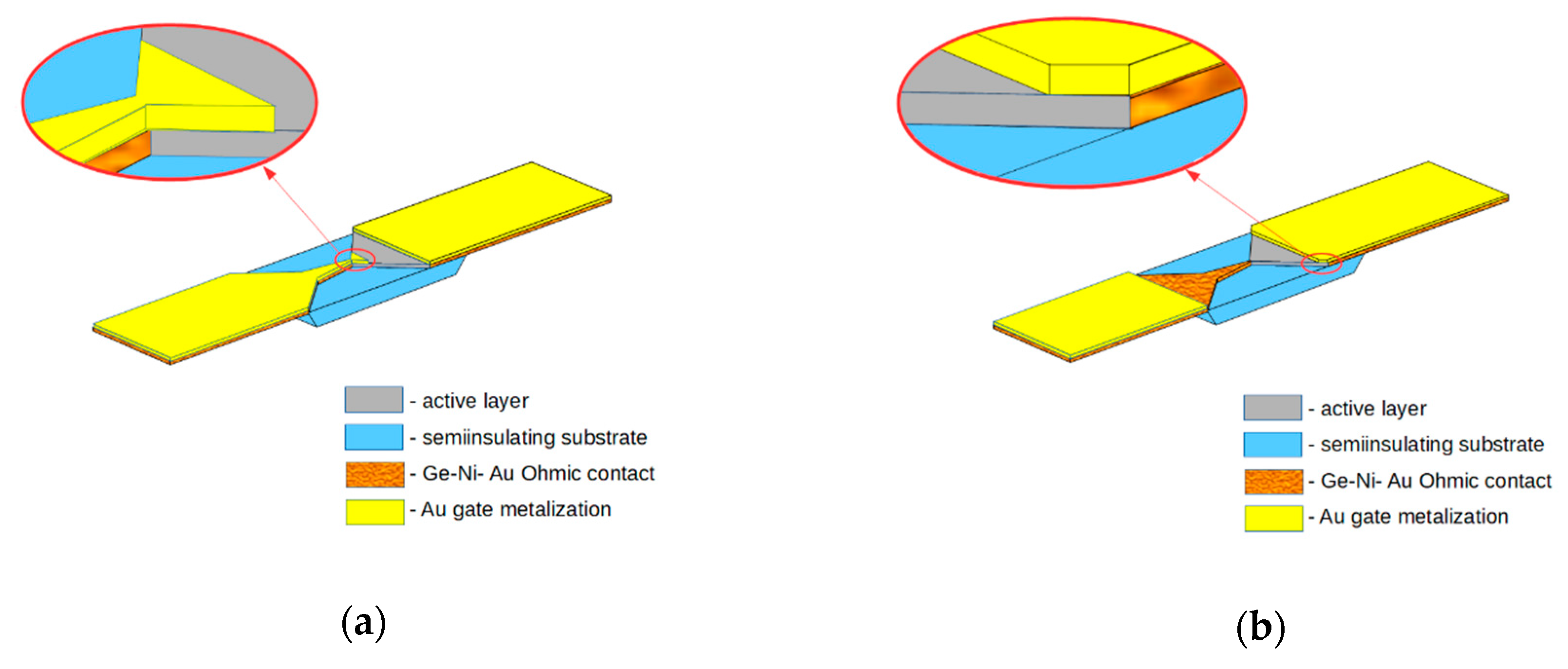
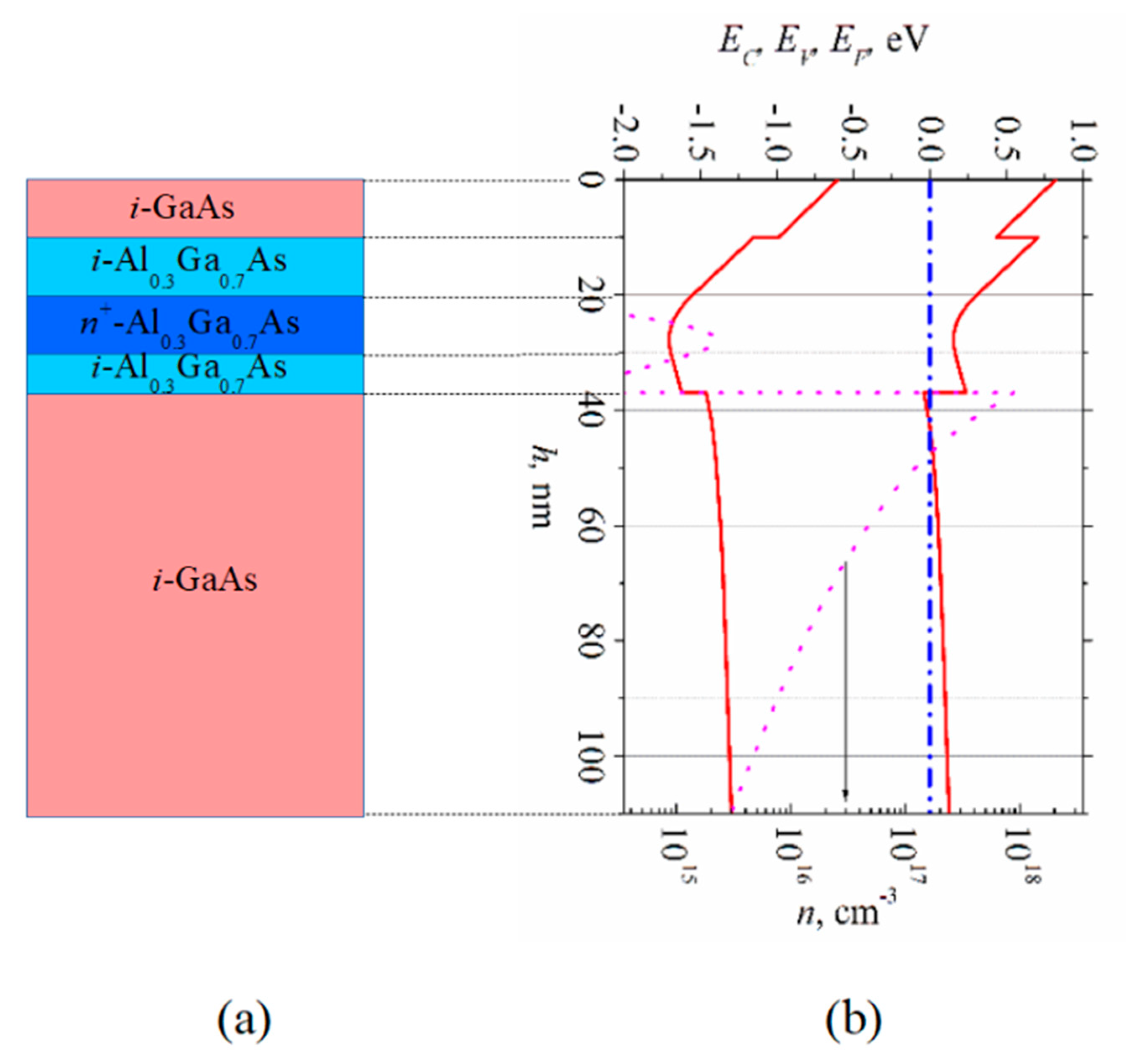
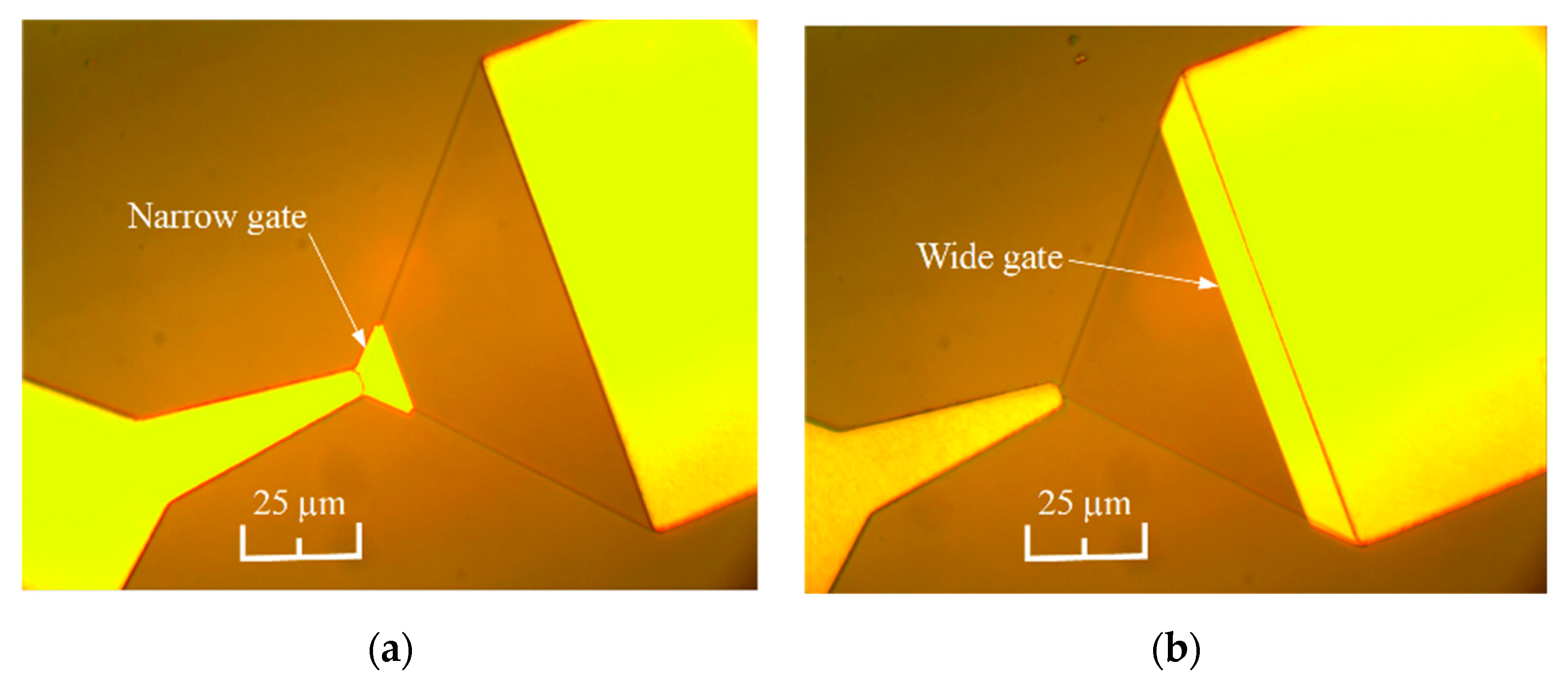
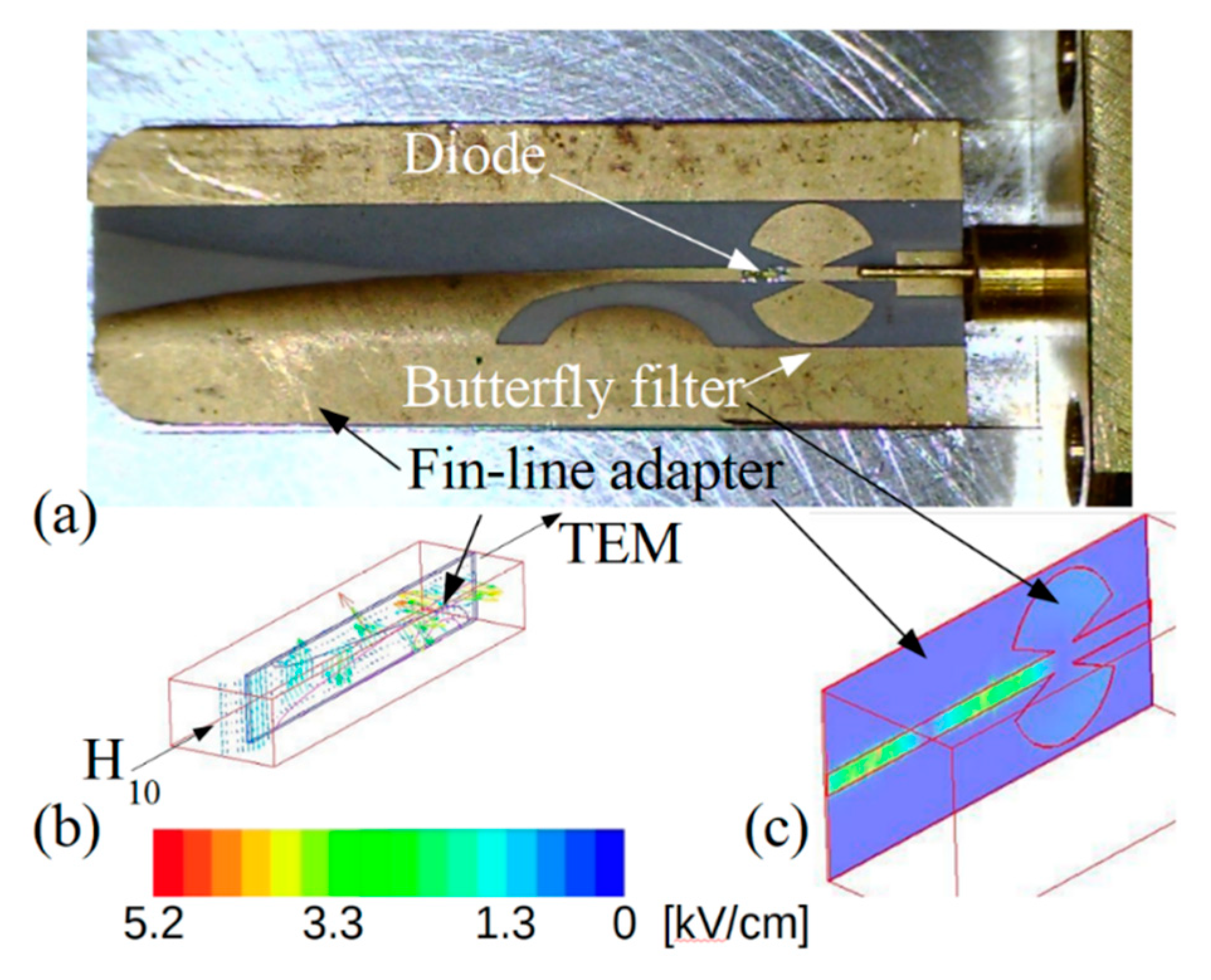
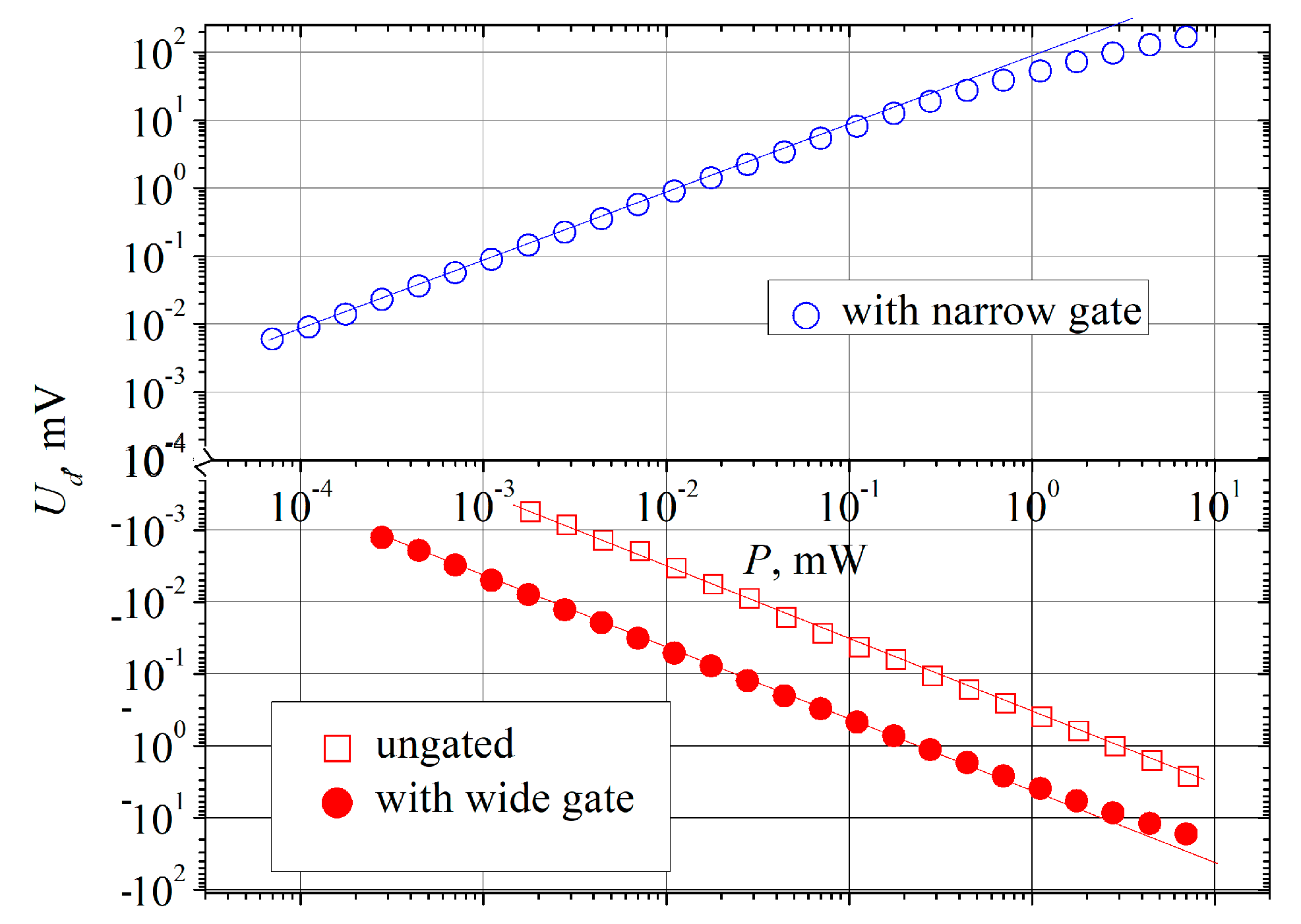
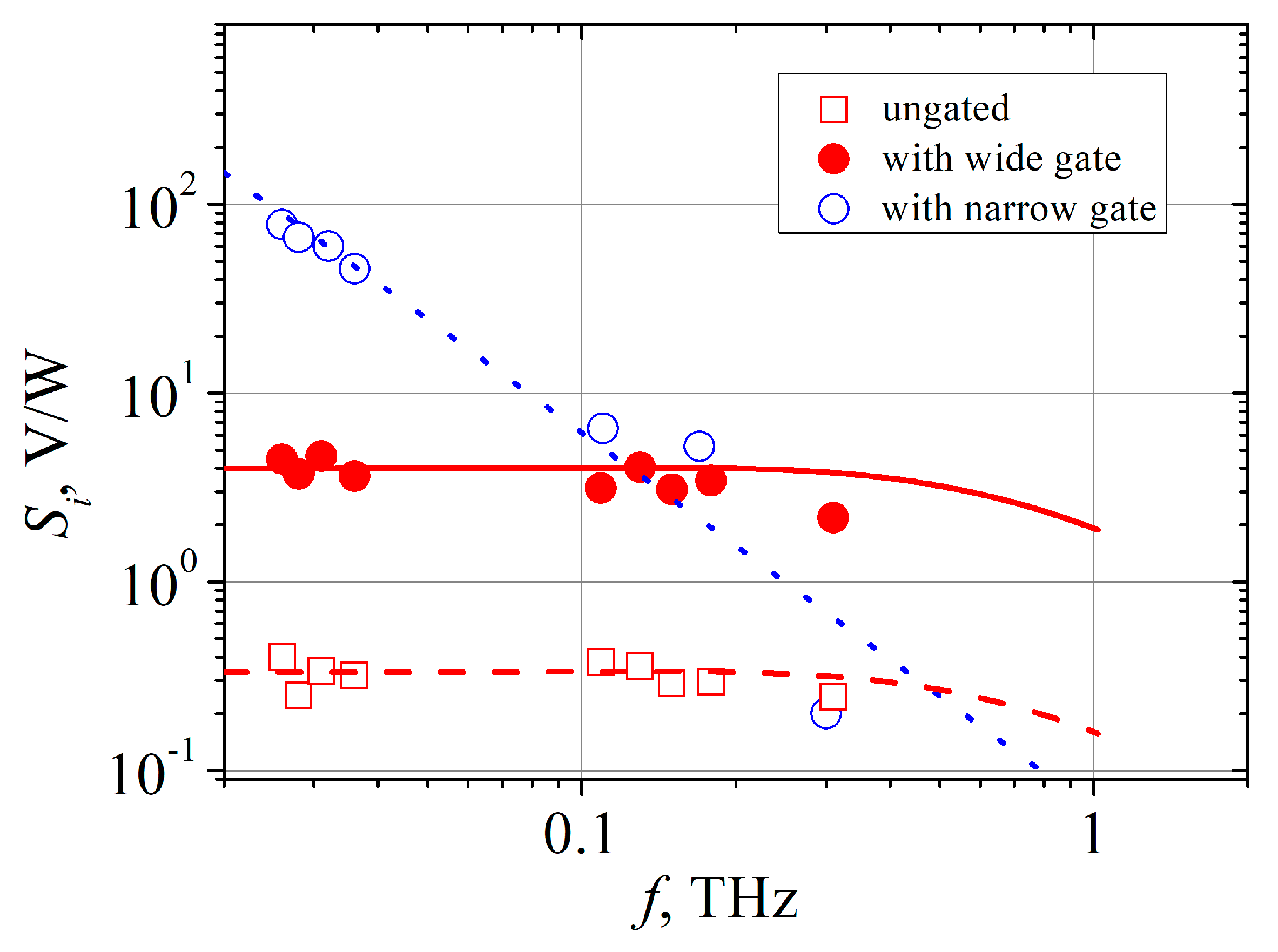
© 2020 by the authors. Licensee MDPI, Basel, Switzerland. This article is an open access article distributed under the terms and conditions of the Creative Commons Attribution (CC BY) license (http://creativecommons.org/licenses/by/4.0/).
Share and Cite
Ašmontas, S.; Anbinderis, M.; Čerškus, A.; Gradauskas, J.; Sužiedėlis, A.; Šilėnas, A.; Širmulis, E.; Umansky, V. Gated Bow-Tie Diode for Microwave to Sub-Terahertz Detection. Sensors 2020, 20, 829. https://doi.org/10.3390/s20030829
Ašmontas S, Anbinderis M, Čerškus A, Gradauskas J, Sužiedėlis A, Šilėnas A, Širmulis E, Umansky V. Gated Bow-Tie Diode for Microwave to Sub-Terahertz Detection. Sensors. 2020; 20(3):829. https://doi.org/10.3390/s20030829
Chicago/Turabian StyleAšmontas, Steponas, Maksimas Anbinderis, Aurimas Čerškus, Jonas Gradauskas, Algirdas Sužiedėlis, Aldis Šilėnas, Edmundas Širmulis, and Vladimir Umansky. 2020. "Gated Bow-Tie Diode for Microwave to Sub-Terahertz Detection" Sensors 20, no. 3: 829. https://doi.org/10.3390/s20030829
APA StyleAšmontas, S., Anbinderis, M., Čerškus, A., Gradauskas, J., Sužiedėlis, A., Šilėnas, A., Širmulis, E., & Umansky, V. (2020). Gated Bow-Tie Diode for Microwave to Sub-Terahertz Detection. Sensors, 20(3), 829. https://doi.org/10.3390/s20030829





